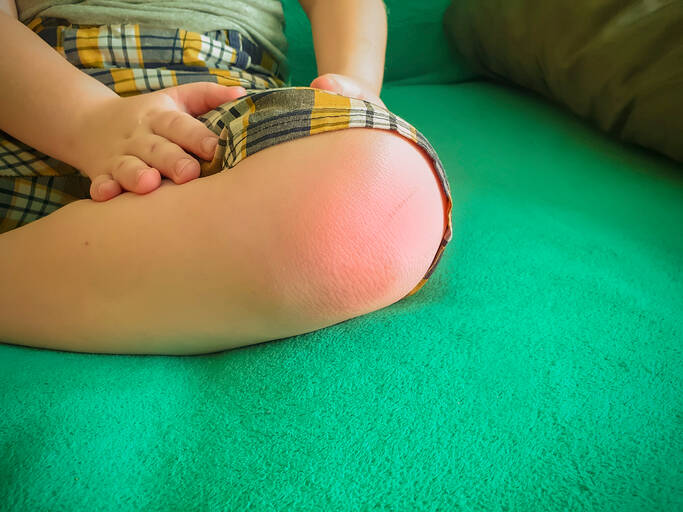- Harris, Julia G.; Kessler, Elizabeth A.; Verbsky, James W. (21 April 2013). "Update on the Treatment of Juvenile Idiopathic Arthritis". Current Allergy and Asthma Reports. 13 (4): 337–346.
- Prakken, B; Albani, S; Martini, A (18 June 2011). "Juvenile idiopathic arthritis". Lancet. 377 (9783): 2138–49.
- Giancane, Gabriella; Consolaro, Alessandro; Lanni, Stefano; Davì, Sergio; Schiappapietra, Benedetta; Ravelli, Angelo (12 August 2016). "Juvenile Idiopathic Arthritis: Diagnosis and Treatment". Rheumatology and Therapy. 3 (2): 187–207
- Hemke, Robert; Nusman, Charlotte M.; van der Heijde, Désirée M. F. M.; Doria, Andrea S.; Kuijpers, Taco W.; Maas, Mario; van Rossum, Marion A. J. (14 August 2014). "Frequency of joint involvement in juvenile idiopathic arthritis during a 5-year follow-up of newly diagnosed patients: implications for MR imaging as outcome measure". Rheumatology International. 35 (2): 351–357.
- Sen, Ethan S.; Dick, Andrew D.; Ramanan, Athimalaipet V. (31 March 2015). "Uveitis associated with juvenile idiopathic arthritis". Nature Reviews Rheumatology. 11 (6): 338–348.
- Foster, H.; Rapley, T.; May, C. (17 November 2009). "Juvenile idiopathic arthritis: improved outcome requires improved access to care". Rheumatology. 49 (3): 401–403.
- Bechtold, Susanne; Simon, Dominique (24 April 2014). "Growth abnormalities in children and adolescents with juvenile idiopathic arthritis". Rheumatology International. 34 (11): 1483–1488.
- Burnham, Jon M.; Shults, Justine; Dubner, Sarah E.; Sembhi, Harjeet; Zemel, Babette S.; Leonard, Mary B. (August 2008). "Bone density, structure, and strength in juvenile idiopathic arthritis: Importance of disease severity and muscle deficits". Arthritis & Rheumatism. 58 (8): 2518–2527.
- Prahalad S, Glass DN (2002). "Is juvenile rheumatoid arthritis/juvenile idiopathic arthritis different from rheumatoid arthritis?". Arthritis Research. 4 (Suppl 3): 303–310.
- Hinks A, Cobb J, Marion MC, Prahalad S, Sudman M, Bowes J, et al. (June 2013). "Dense genotyping of immune-related disease regions identifies 14 new susceptibility loci for juvenile idiopathic arthritis". Nature Genetics. 45 (6): 664–9
- Phelan JD, Thompson SD (September 2006). "Genomic progress in pediatric arthritis: recent work and future goals". Current Opinion in Rheumatology. 18 (5): 482–9.
- Førre O, Smerdel A (2002). "Genetic epidemiology of juvenile idiopathic arthritis". Scandinavian Journal of Rheumatology. 31 (3): 123–8.
- Balan, Suma (9 January 2016). "Approach to Joint Pain in Children". The Indian Journal of Pediatrics. 83 (2): 135–139
- msdmanuals.com - Juvenile Idiopathic Arthritis (JIA)
- ghr.nlm.nih.gov - Juvenile idiopathic arthritis
- jia.org.uk - What is JIA?
- versusarthritis.org - What is juvenile idiopathic arthritis?
- arthritis.org
- stanfordchildrens.org
- rheumatology.org - Juvenile Arthritis
Juvenile idiopathic arthritis: Symptoms of rheumatism, arthritis in children?

Photo source: Getty images
Most common symptoms
- Malaise
- Sweating
- Feeling of heavy legs
- Abdominal Pain
- Headache
- Joint Pain
- Limb pain
- Leg Pain
- Eye Pain
- Muscle Pain
- Flank Pain
- Groin Pain
- Sensitivity to light
- Fever
- Nausea
- Deformed nails
- Depression - depressed mood
- Bone Pain
- Rash
- Indigestion
- Swollen fingers
- Swollen eyelid
- Eye irritation
- Malnutrition
- Back Pain
- Buds
- Muscle weakness
- Itchy skin
- Itchy eye
- Fatigue
- Reddened skin
- Deterioration of vision
- Enlarged lymph nodes
- Liver enlargement
Show more symptoms ᐯ
How is Juvenile Idiopathic Arthritis treated? Medication, biological treatment and lifestyle
Show more









